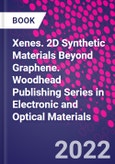Xenes: 2D Synthetic Materials Beyond Graphene includes all the relevant information about Xenes thus far reported, focusing on emerging materials and new trends. The book's primary goal is to include full descriptions of each Xene type by leading experts in the area. Each chapter will provide key principles, theories, methods, experiments and potential applications. The book also reviews the key challenges for synthetic 2D materials such as characterization, modeling, synthesis, and integration strategies. This comprehensive book is suitable for materials scientists and engineers, physicists and chemists working in academia and R&D in industry.
The discovery of silicene dates back to 2012. Since then, other Xenes were subsequently created with synthetic methods. The portfolio of Xenes includes different chemical elements of the periodic table and hence the related honeycomb-like lattices show a wealth of electronic and optical properties that can be successfully exploited for applications.
Please Note: This is an On Demand product, delivery may take up to 11 working days after payment has been received.
Table of Contents
Section 1: Xenes: Materials aspects
1. Silicene
2. Germanene
3. Stanene and Plumbene
4. Borophene
5. Gallenene
6. Phosphorene
7. Arsenene and Antimonene
8. Bismuthene
9. Selenene and Tellurene
Section 2: Xenes: Challenges in science and technologies
10. Technical evolution for the identification of Xenes: from atomically resolved microscopy to Raman and photoemission spectroscopies
11. Chemical synthesis of the Xenes
12. Topological properties of the Xenes
13. Xenes heterostructures
14. Integration paths for Xenes








